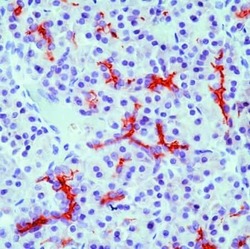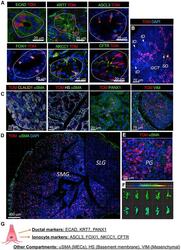MA5-11768
antibody from Invitrogen Antibodies
Targeting: CFTR
ABC35, ABCC7, CF, CFTR/MRP, dJ760C5.1, MRP7, TNR-CFTR
Antibody data
- Antibody Data
- Antigen structure
- References [12]
- Comments [0]
- Validations
- Immunohistochemistry [1]
- Other assay [1]
Submit
Validation data
Reference
Comment
Report error
- Product number
- MA5-11768 - Provider product page

- Provider
- Invitrogen Antibodies
- Product name
- CFTR Monoclonal Antibody (M3A7)
- Antibody type
- Monoclonal
- Antigen
- Recombinant full-length protein
- Description
- MA5-11768 targets Cystic Fibrosis Transmembrane Regulator in IF, IHC (P), IP, and WB applications and shows reactivity with Human, mouse, and Rat samples. The MA5-11768 immunogen is recombinant protein encoding NBF2 domain of human CFTR.
- Reactivity
- Human, Mouse, Rat
- Host
- Mouse
- Isotype
- IgG
- Antibody clone number
- M3A7
- Vial size
- 500 μL
- Concentration
- 0.2 mg/mL
- Storage
- 4°C
Submitted references A mesenchymal to epithelial switch in Fgf10 expression specifies an evolutionary-conserved population of ionocytes in salivary glands.
CFTR is restricted to a small population of high expresser cells that provide a forskolin-sensitive transepithelial Cl- conductance in the proximal colon of the possum, Trichosurus vulpecula.
The distribution and expression of CFTR restricts electrogenic anion secretion to the ileum of the brushtail possum, Trichosurus vulpecula.
Multipotent stem/progenitor cells in human biliary tree give rise to hepatocytes, cholangiocytes, and pancreatic islets.
Endogenous luminal surface adenosine signaling regulates duodenal bicarbonate secretion in rats.
Expression of cystic fibrosis transmembrane conductance regulator in paracervical ganglia.
Molecular and functional characterization of the cystic fibrosis transmembrane conductance regulator from the Australian common brushtail possum, Trichosurus vulpecula.
Expression and distribution of cystic fibrosis transmembrane conductance regulator in neurons of the spinal cord.
Expression and distribution of cystic fibrosis transmembrane conductance regulator in neurons of the human brain.
Morphological and functional heterogeneity of the mouse intrahepatic biliary epithelium.
Small mouse cholangiocytes proliferate in response to H1 histamine receptor stimulation by activation of the IP3/CaMK I/CREB pathway.
Expression of cystic fibrosis transmembrane conductance regulator in ganglion cells of the hearts.
Mauduit O, Aure MH, Delcroix V, Basova L, Srivastava A, Umazume T, Mays JW, Bellusci S, Tucker AS, Hajihosseini MK, Hoffman MP, Makarenkova HP
Cell reports 2022 Apr 12;39(2):110663
Cell reports 2022 Apr 12;39(2):110663
CFTR is restricted to a small population of high expresser cells that provide a forskolin-sensitive transepithelial Cl- conductance in the proximal colon of the possum, Trichosurus vulpecula.
Fan S, Harfoot N, Bartolo RC, Butt AG
The Journal of experimental biology 2012 Apr 1;215(Pt 7):1218-30
The Journal of experimental biology 2012 Apr 1;215(Pt 7):1218-30
The distribution and expression of CFTR restricts electrogenic anion secretion to the ileum of the brushtail possum, Trichosurus vulpecula.
Gill M, Bartolo RC, Demmers K, Harfoot N, Fan S, Butt G
The Journal of experimental biology 2011 Jun 1;214(Pt 11):1943-54
The Journal of experimental biology 2011 Jun 1;214(Pt 11):1943-54
Multipotent stem/progenitor cells in human biliary tree give rise to hepatocytes, cholangiocytes, and pancreatic islets.
Cardinale V, Wang Y, Carpino G, Cui CB, Gatto M, Rossi M, Berloco PB, Cantafora A, Wauthier E, Furth ME, Inverardi L, Dominguez-Bendala J, Ricordi C, Gerber D, Gaudio E, Alvaro D, Reid L
Hepatology (Baltimore, Md.) 2011 Dec;54(6):2159-72
Hepatology (Baltimore, Md.) 2011 Dec;54(6):2159-72
Endogenous luminal surface adenosine signaling regulates duodenal bicarbonate secretion in rats.
Ham M, Mizumori M, Watanabe C, Wang JH, Inoue T, Nakano T, Guth PH, Engel E, Kaunitz JD, Akiba Y
The Journal of pharmacology and experimental therapeutics 2010 Dec;335(3):607-13
The Journal of pharmacology and experimental therapeutics 2010 Dec;335(3):607-13
Expression of cystic fibrosis transmembrane conductance regulator in paracervical ganglia.
Su M, Guo Y, Zhao Y, Korteweg C, Gu J
Biochemistry and cell biology = Biochimie et biologie cellulaire 2010 Aug;88(4):747-55
Biochemistry and cell biology = Biochimie et biologie cellulaire 2010 Aug;88(4):747-55
Molecular and functional characterization of the cystic fibrosis transmembrane conductance regulator from the Australian common brushtail possum, Trichosurus vulpecula.
Demmers KJ, Carter D, Fan S, Mao P, Maqbool NJ, McLeod BJ, Bartolo R, Butt AG
Journal of comparative physiology. B, Biochemical, systemic, and environmental physiology 2010 Apr;180(4):545-61
Journal of comparative physiology. B, Biochemical, systemic, and environmental physiology 2010 Apr;180(4):545-61
Expression and distribution of cystic fibrosis transmembrane conductance regulator in neurons of the spinal cord.
Guo Y, Su M, Su M, McNutt MA, Gu J
Journal of neuroscience research 2009 Dec;87(16):3611-9
Journal of neuroscience research 2009 Dec;87(16):3611-9
Expression and distribution of cystic fibrosis transmembrane conductance regulator in neurons of the human brain.
Guo Y, Su M, McNutt MA, Gu J
The journal of histochemistry and cytochemistry : official journal of the Histochemistry Society 2009 Dec;57(12):1113-20
The journal of histochemistry and cytochemistry : official journal of the Histochemistry Society 2009 Dec;57(12):1113-20
Morphological and functional heterogeneity of the mouse intrahepatic biliary epithelium.
Glaser SS, Gaudio E, Rao A, Pierce LM, Onori P, Franchitto A, Francis HL, Dostal DE, Venter JK, DeMorrow S, Mancinelli R, Carpino G, Alvaro D, Kopriva SE, Savage JM, Alpini GD
Laboratory investigation; a journal of technical methods and pathology 2009 Apr;89(4):456-69
Laboratory investigation; a journal of technical methods and pathology 2009 Apr;89(4):456-69
Small mouse cholangiocytes proliferate in response to H1 histamine receptor stimulation by activation of the IP3/CaMK I/CREB pathway.
Francis H, Glaser S, Demorrow S, Gaudio E, Ueno Y, Venter J, Dostal D, Onori P, Franchitto A, Marzioni M, Vaculin S, Vaculin B, Katki K, Stutes M, Savage J, Alpini G
American journal of physiology. Cell physiology 2008 Aug;295(2):C499-513
American journal of physiology. Cell physiology 2008 Aug;295(2):C499-513
Expression of cystic fibrosis transmembrane conductance regulator in ganglion cells of the hearts.
Pan P, Guo Y, Gu J
Neuroscience letters 2008 Aug 15;441(1):35-8
Neuroscience letters 2008 Aug 15;441(1):35-8
No comments: Submit comment
Supportive validation
- Submitted by
- Invitrogen Antibodies (provider)
- Main image

- Experimental details
- Formalin-fixed, paraffin-embedded human pancreas stained with CFTR antibody using peroxidase-conjugate and AEC chromogen. Note membrane staining of epithelial cells in the intercalated ducts.
Supportive validation
- Submitted by
- Invitrogen Antibodies (provider)
- Main image

- Experimental details
- Figure 4. In adult SMGs and PGs, FGF10 pos cells are restricted to the ED, SD, and GCT ducts and express ionocyte markers (A) In adult glands, FGF10 pos cells (TOM, red) express E-cadherin (ECAD, green), KRT7 (green), ASCL3 (green), FOXI1 (green), NKCC1 (green), and CFTR (green), which are expressed at the apical membrane of FGF10 pos cells. Nuclei labeled with DAPI (blue). (B) In adult SMG FGF10 pos cells (TOM, red) were found in the GCTs (red arrows) and SDs (yellow arrows) but not in the IDs (white arrows). (C) FGF10 pos cells were labeled at P29/30 (TOM, red) and stained with different antibodies. Acini were labeled with claudin (orange); MECs were labeled with alphaSMA (green); the basement membrane was labeled with heparan sulfate (HS) (gray); ducts were labeled with pannexin-1 (PANX1); stromal cells were labeled with VIM (green); nuclei labeled with DAPI (blue). (D and E) FGF10 pos cells (TOM, red) were found within ducts of SMGs (D) and PGs (E), while not in SLGs (D). FGF10 pos cells were detected only within the mesenchyme. (F) IMARIS bounding box software was used to analyze shape and size of FGF10 pos cells. (G) Summary of immunostaining used to label different cell types and gland compartments. Also see Figures S4 and S5 , Data S6 .
 Explore
Explore Validate
Validate Learn
Learn Western blot
Western blot Immunohistochemistry
Immunohistochemistry